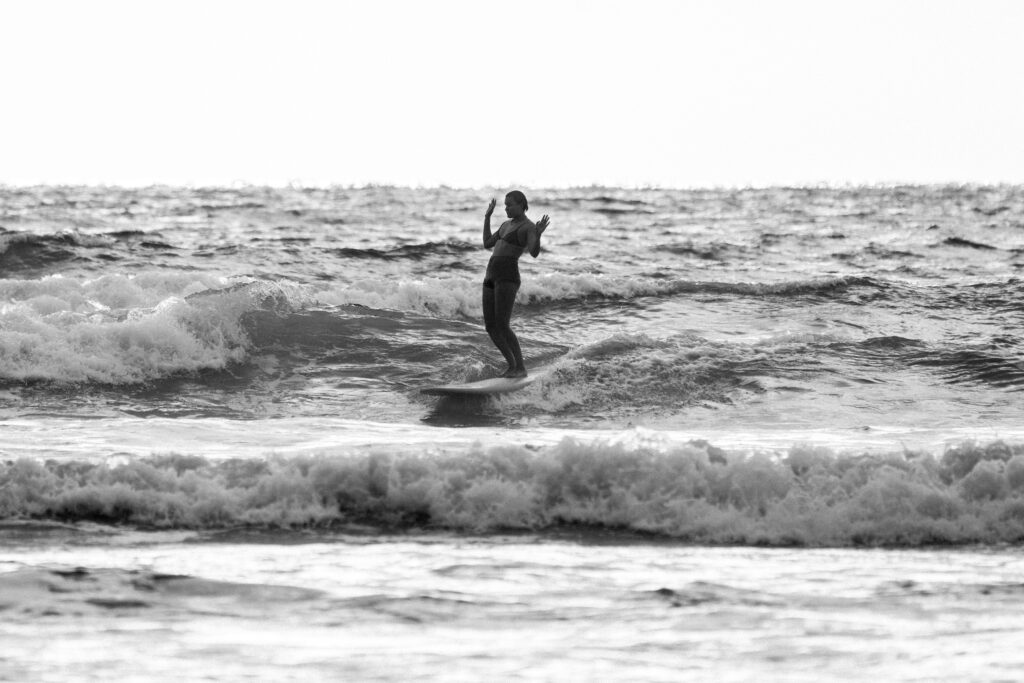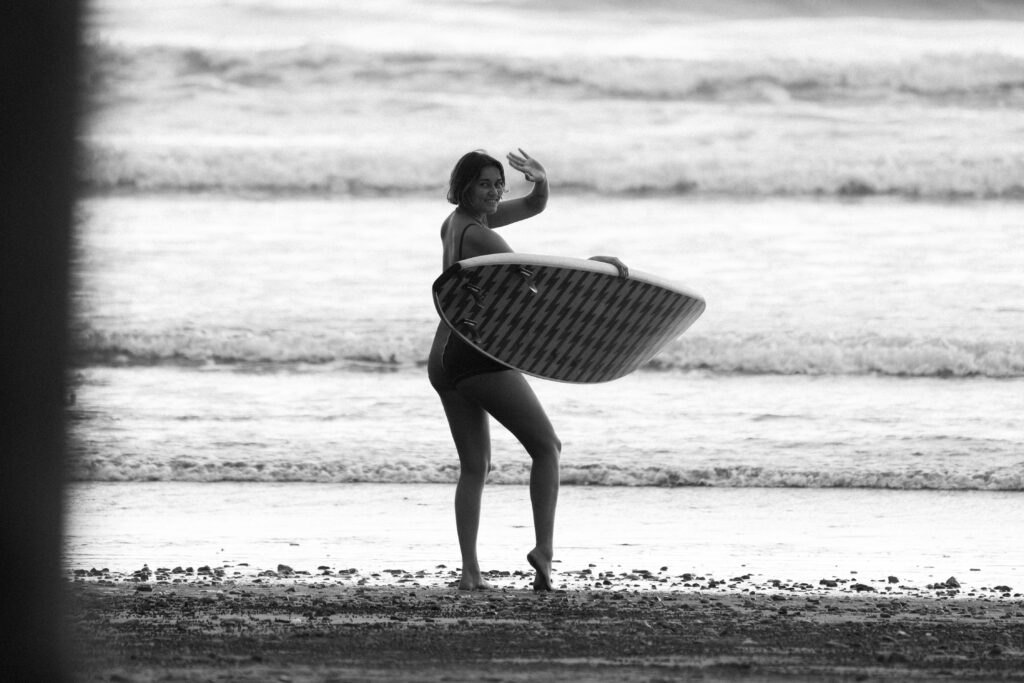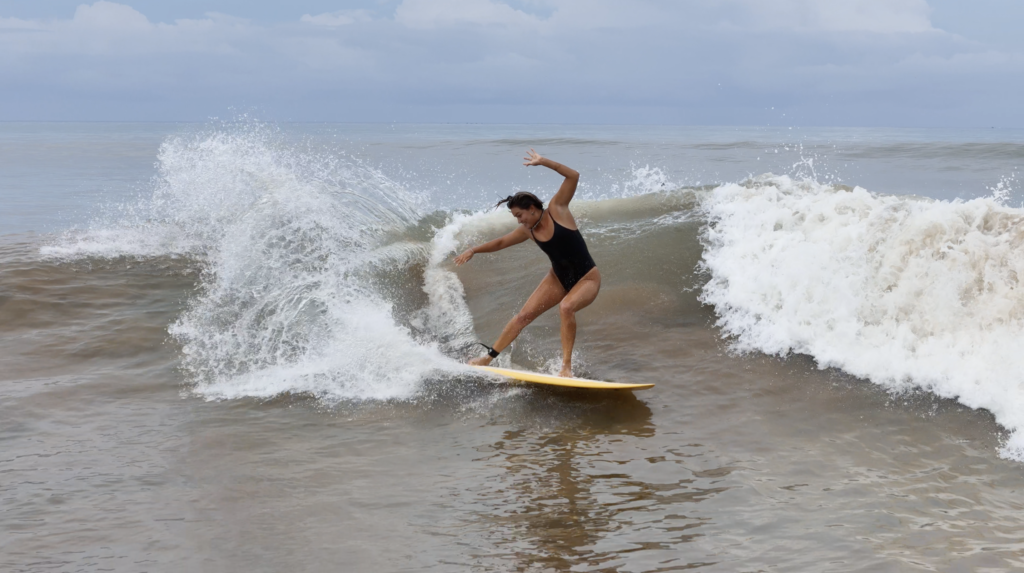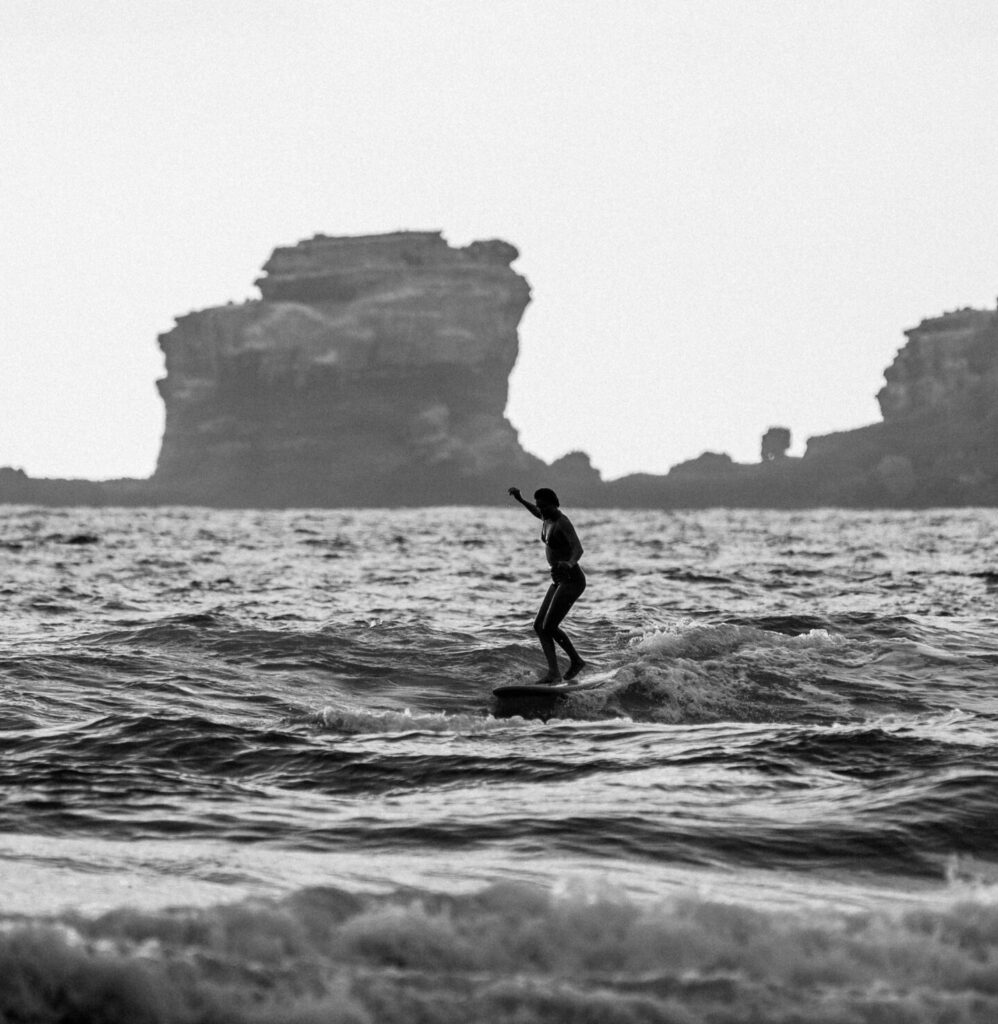Pacha Light on fear, nature, and amplifying Indigenous voices in climate action.
Pacha Light’s story begins in the misty cloud forests of Ecuador, where she spent the first six years of her life. With parents who met replanting mangroves, Pacha and her brother were raised with a foundational understanding of the interconnectedness between humans and the natural world––something that shaped Pacha’s present approach to surfing and conservation storytelling. Pacha’s mother, an environmental activist and advocate of Indigenous rights, shaped much of her daughter’s approach to nature and life. At nine, guided by what she lovingly calls an “experimental” parenting style, she discovered her love for the ocean and surfing.
From pro surfer to ocean advocate and environmentalist, Pacha walks the talk.
LB: I read that you grew up in a stone house deep in the Ecuadorian forest. How did that chapter of your life shape your relationship with the natural world?
PL: That time was so special. The stone house had no electricity, no running water, it was completely off grid. The land, bought by my mum to protect it from logging, was four hours from the Cotacachi and about an hour walk from the nearest dirt road.
From mine and my brother’s memory, it was pure freedom and joy. We didn’t have much—just a few books that we would read when it got darker—but we’d be playing all day. With the horses, running through the forest, spending time in the river, having our shower time there. It was pure magic. I moved to Australia when I was six, but we would return to Ecuador every five years and spend most of the time up there in the mountains.
Those first connections to nature and intense experiences as a kid really set me up on the path I’m on now. Particularly the idea that the forest, the raging river, or a wild sea weren’t things to be afraid of —rather just life flourishing on its own. Nature as its own entity is something to respect, but not to fear.
Even in terms of that body clock—I could hear the birds start to change their tone, hear the cicadas pick up, and know it was dusk, time to go to bed. It’s so beautiful because with surfing, there’s a very similar connection where you need to be in tune with nature. You have to be looking at swell charts and wind patterns, but also paying attention to how the water moves, the times of day, the sunrise and sunset.
The forest, the raging river, or a wild sea weren’t things to be afraid of—rather just life flourishing on its own.

LB: You started surfing in Australia, can you tell me how you fell in love with the sport?
PL: In Australia, it’s really common to have board riders clubs—local crews meeting up to surf together. My brother and I just showed up one day during a local event, and they let us borrow some boards to take out and play in the water. We fell in love with surfing that day. After that experience, I really wanted my own surfboard, but it wasn’t easy for my mum to afford at the time. She asked me to get creative: after dancing at a market on the Gold Coast for hours and hours, I decided to do it at a surf contest with a little sign saying “busking for a surfboard.”
At that contest, pro surfer Laura Enever came by and danced with me—I thought she was just a random teenager. After dancing together, she came back with one of her old boards and gave it to me. That was the start of everything. After that, I surfed every single day. Laura and I stayed in touch, and we both ended up joining the Billabong team at the same time. It became this complete sisterhood and nurturing relationship—an introduction to surfing with such generosity.
Every time I travel now, I take some old boards and pass them on because you never know what it might lead to. It led me to amazing stories, new friends, and a beautiful surfing community all around the world.
LB: Can you tell me about your transition from competitive surfing into more community oriented activism?
PL: As a competitive surfer or any other competing athlete, there is pretty much just a single-minded goal of being the best. You can’t enter a contest without having that mentality because otherwise, what’s the point?
At 19, I realized that my focus had changed—being the best in the world wasn’t a priority for me anymore–– it was to connect to people and communities. Exploring that through surfing was going to be so much more fulfilling. I started to look at stories that were connected with the sea and find ways to amplify them. I started with a project called Women of the Sea––a story about South Korean and Japanese female divers. That led me to pitch a film to Lucy Small and Maddie Meddings, who had just created Yama, which is a film about women’s surf and skate culture in Ghana.
LB: Can you tell me about your film Ceibo, what does the project explore?
PL: Ceibo is like a love letter to Ecuador. It represents how I’ve always viewed Ecuador as a place of strong, empowered young women, being leading personalities in their communities.
I wanted to talk about four different women in Ecuador––from the Andes, the Amazon, the coastline, and the Galapagos––each pioneering the way as female environmentalists. The film looks at the importance of indigenous knowledge and the need to strengthen indigenous territories and communities, as the best way to do conservation. The movie also explores questions of my own connection to Ecuador and Lucy’s connection to activism and how different it can be for every woman that we talked to.
Another core idea of the project, aside from the importance of indigenous knowledge, is to take a look in the mirror, and recognise how our overconsumption and demands are causing destruction in these beautiful places. But there is hope through women leading in their communities, creating new pathways, and solutions.
LB: Through the making of Ciebo, what have you learned about the role of indigenous communities in the protection of nature?
PL: Eighty percent of the world’s biodiversity lies within indigenous territories, and those communities are actively participating in conservation. It’s important to understand that protecting territories not only means preserving nature, but also means protecting history, language, memories, and culture. I think this is particularly important for marine protected areas, especially here in Australia. We’re seeing many of these national and marine parks being managed by local indigenous communities—people who have always been on that land and have a cultural connection to it.
The idea that indigenous knowledge means going backwards is outdated––it’s quite the opposite. Innovation is happening through incorporating indigenous knowledge and current scientific data. That coexistence is very important, the solutions to tackle climate issues must be indigenous-led.
Ecuador added the Rights of Nature into its constitution in 2008—it is the first country to do so. They’ve saved river systems, forests, mountain faces, and even now it’s bridging into coastline and ocean conservation. It’s a beautiful idea that draws from indigenous knowledge that this place isn’t just property.
It’s so important to understand these connections. Conservation or protecting ecosystems has a direct link to the health of communities and the health of our planet. Not only our physical health, but also our mental health. To protect nature means to protect ourselves. To heal nature means to heal ourselves.
Community is the basis of indigenous wisdom, indigenous cultures understand the importance of community and helping each other rather than acting against each other. That’s exactly what we try to do with our film.

LB: Surfing has been an ancient practice and activity that can be found in different shapes and forms all around the globe. Looking ahead, what potential do you think surfing has in raising awareness?
PL: I feel like surfing can be a vehicle for connecting people to nature and strengthening that relationship in such a beautifully soft and loving way.
We have this idea that it needs to be a really rude shock to the system to get people to wake up and see what is happening to the world to make those lifestyle changes. But maybe it can be through love, hope and through celebration, through being in the water, through surfing. No matter what, when you’re surfing, you’re in the ocean and it will just present you with the lesson that you need to get through that day.
Riding a wave that’s been traveling for thousands of kilometers––just that energy that you feel after you catch a wave. I don’t understand the science of it, but I know how it feels… It’s a gift.
It’s amazing to see the history of wave riding and how the activity, in different shapes and forms has rippled through all these different cultures. Indigenous people riding waves from Ecuador to Australia, from Hawaii to Peru.
I think surfing can be the bridge and connection to activism. It just comes naturally through the love of the ocean, it’s pretty hard to see the place you love be under threat.
We’re very lucky here in Australia. We have quite an amazing infrastructure here that has been made available in the last five years with organisations like Surfers for Climate, Surf Rider Foundation and Save the Waves Coalition. Surfers for Climate really built a bridge between surfers and politicians and made effective protection of our surf spots and coastlines possible.
Let me give you an example, I’m here in Noosa, Queensland, Australia. A majority of the people in the city council are surfers. They protected their beachfront as a World Surfing Reserve. They have limited all development on those beachfront areas and labeled parts of it as a National Park. They focused on those marine conservation areas and made sure that there’s been no encroaching on those sanctuaries. There’s an incredible sense of pride here about the coastline, everyone shares that with the people who travel here. It’s like, “look at this as a blueprint.”
LB: Can you give insight into the relationship between brands, professional surfers and the industry all within the context of their impacts on the environment?
PL: There’s been growth in people pursuing surfing as an activity, but its only quite recent that brands and surf media have been focusing more on climate.
There has been some change lately, a lot of surf brands are being exposed, making clear who really owns and funds them. There’s been more focus on the materials we are using, how our surfboards are being made, the whole story of neoprene, made from chloroprene, a compound made out of petrochemicals, contributing to Cancer Alley. We’ve produced our wetsuits for nearly three decades like this.
At the end of the day, the finances and the money trails make the decisions. There’s quite a lot of darkness and wild funding in a lot of these surf companies. They’re mainly owned by a select few, BlackRock being one of them. It’s important to understand that this financial trail has had quite a destructive effect on local and indigenous communities and the environment.
It’s hard for me to have faith in mainstream surf brands to make those changes. It has to come from the consumer. I think doing your own research can have a lot of power. Once I decided to learn I stepped away from my old sponsors. I was deeply fascinated with understanding not only a company’s environmental impact, but also the treatment of employees, the treatment of animals through animal testing, the manufacturing and then what happens after the product has been produced. Having that knowledge really changed my decision making.
Now there’s really no excuse—we have the information, we have the studies—I feel like more surfers need to face those facts of the impact that they’re having.

LB: Within professional surfing, how does the sport shape surfers’ perspectives or experiences in ways that influence their path into activism?
PL: I think that pro surfers have been quite controlled by who puts food on their table in the past. It isn’t as easy for pro’s to have stronger opinions on those things, but I feel like it’s shifting and I feel like people are using their platforms more.
The surfing industry has an amazing opportunity to really reiterate the right values. I wish more pro surfers, especially those on the world tour, would have the courage to really understand where we stand in terms of ocean health and then to walk the talk. But at the same time, I do understand that perspective and mindset where there’s only one thing that you can really think of and that is to win.
I think we’re seeing a shift in the surf industry, people are more curious nowadays about ocean conservation or other stories of local communities from around the world.
LB: So education is a big part of your own journey as an activist. What have you learned through collaborating with organisations outside of the surf world?
PL: I’ve learned so much from partnering with many different organisations and campaigns. I recently connected with a group that focuses more on forest conservation in Panama, Costa Rica, and Ecuador. They were studying leatherback turtle migration patterns and wanted to expand one marine protected area from one island close to Panama up to the Galapagos Islands. The knowledge that a turtle would be travelling distances and use those migrations routes was just so incredible to me. It just gives that motivation as an athlete that there’s value in digging deeper and advocating for change in your sponsors’ meeting rooms.
LB: As a last question, how do you envision the future of surfing?
PL: We ride a wave for one second and then the wave’s gone—it’s quite meaningless in a way. There’s no transactional physical thing that we can take away from it. It’s just how we feel. I just hope that some of these lessons that we feel out in the ocean replicate into the industry, into the bigger picture, and into legislation.
I would just love for people to embrace that love and joy that comes with surfing and understand that people have been riding waves for thousands of years. It’s about paying respects and embracing that magic.
